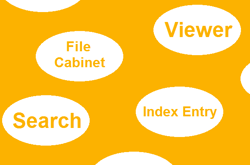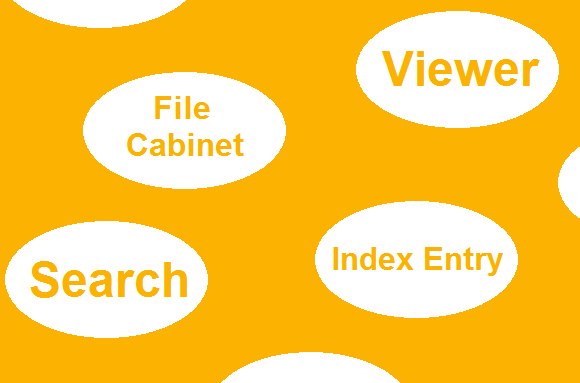 File cabinets, document trays or index fields – if you are new to DocuWare, it’s helpful to know some key terminology. This will help you get started and if you ever do need some extra help, you’ll know exactly what to ask about.
File cabinets, document trays or index fields – if you are new to DocuWare, it’s helpful to know some key terminology. This will help you get started and if you ever do need some extra help, you’ll know exactly what to ask about.
To work with DocuWare, you don’t need a particularly broad software vocabulary since most terms are ones you’ll recognize from working with a paper filing system. See for yourself, which terms you might be familiar – from C for client to V for viewer.
Client
You’ve opened DocuWare in your browser? That’s DocuWare Client.
Document Tray
You can sort, staple, edit, and store documents in a document tray. Documents are then available to other users. New documents are imported or scanned into your document tray first or you can drag & drop files into it.
Email Notification
DocuWare automatically lets you know via email if a new document is pending for you or when a task might be nearing a deadline.
File Cabinets
All documents are stored in electronic file cabinets, so that they have a safe and secure place for the long-term. In DocuWare Client, a search will lead you into each file cabinet to retrieve documents. You can Create File Cabinets with a Few Mouse Clicks. It’s also a good idea to spend some time mapping out your archiving approach in advance by Planning Your File Cabinets.
Folders
This is the workspace in DocuWare Client, where you can find all your Documents in a Folder Structure. For example, an accounting file cabinet might have a folder for each year, which might contain folders for individual cost centers, which in turn could have folders for various vendors. This is a very intuitive way to work, especially if you are not regularly working with DocuWare, and an easy way to find documents and manage your Document Storage.
Forms
With DocuWare Forms, you can digitalize recurring processes in your company, ones which were previously handled by manually filling out forms. For example, a form that had to be filled out for every new purchase order.
Index Entry
Before a document is stored in a file cabinet, DocuWare assigns it with index entries, which are used for further processing. Typical index entries are, for example, a filing date or company name. These index entries serve as criteria for sorting and searching for documents in the system. Index entries can also be automatically assigned (by using Intelligent Indexing or AutoIndex) by transferring information from select lists, or through manual entry.
Lists
With a few clicks, you can create handy Lists that contain all the current documents related to a certain project. If a new document is added, this list will automatically be updated for all colleagues involved in the project. To make sure that everyone is truly up-to-date, the team is notified via an automatic email message.
Main Menu and Personal Menu
In the main menu of DocuWare Client, you can install additional apps and connect DocuWare Mobile (the app for your smartphone) to your DocuWare system. In the Personal Menu, you can configure user-specific settings for different parts of the web client and customize your profile.
Result List
After you run a search for a document in DocuWare, you’ll see a Result List. Learn here how to Quickly Find Documents.
Search
With a search, you can find filed documents and then display them on your screen. Let’s say a vendor needs information to process an order. You simply enter a company name or project title and you‘ll gather up offers, purchase orders, correspondence and invoices – all in a clearly structured result list.
Here‘s how you can Quickly Find Documents. If you aren’t sure in which file cabinet a document might be stored, it’s no problem to Search Through Multiple File Cabinets Simultaneously .
Select List
If you want to fill in a field in DocuWare, you are often shown a list of entries; for example, a choice of cost centers. The entries from the list make it easy to avoid typing errors and save time. You can also Import Select Lists into DocuWare and use them to Keep Your File Cabinets Consistent.
Stamps
With a digital Stamp, you can quickly turn around approvals, such as invoices for payment. Stamps can be added in the DocuWare Viewer just like on paper. The big difference is that the stamp doesn’t alter the original document, since you can work with multiple Annotation Layers.
Tasks
All documents that need further processing are collected as tasks in a Task List – like an invoice, that needs to be approved for payment. To help you tackle tasks, a document will then move according to a pre-set order from one person to another (or optionally in parallel) for processing.
Viewer
All documents are displayed in the viewer – whether from a basket, list or folder. All you need to get there is a double-click. In the viewer menu, you will also find Tools such as stamps and markers.
Many Keyboard Shortcuts are also available to help you work with DocuWare. Read our Tips for Getting Started in DocuWare. And in the DocuWare Knowledge Center, you can easily find help on various topics with a handy search field.

